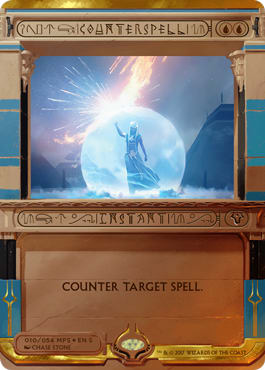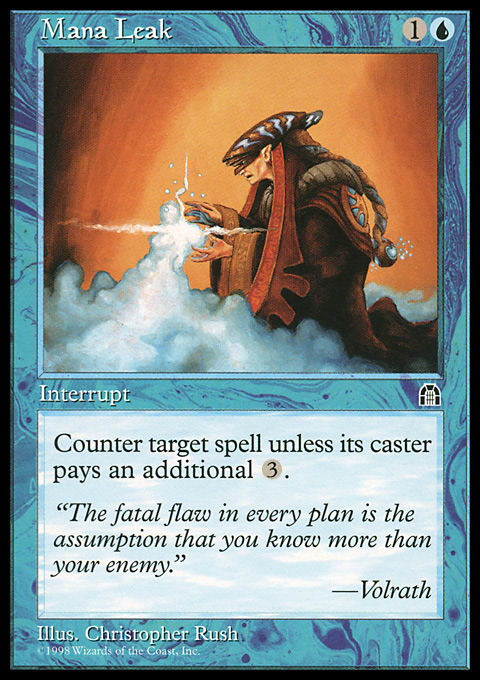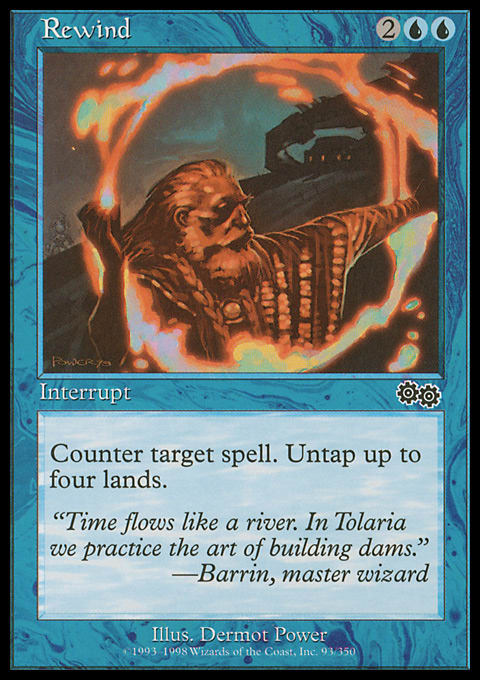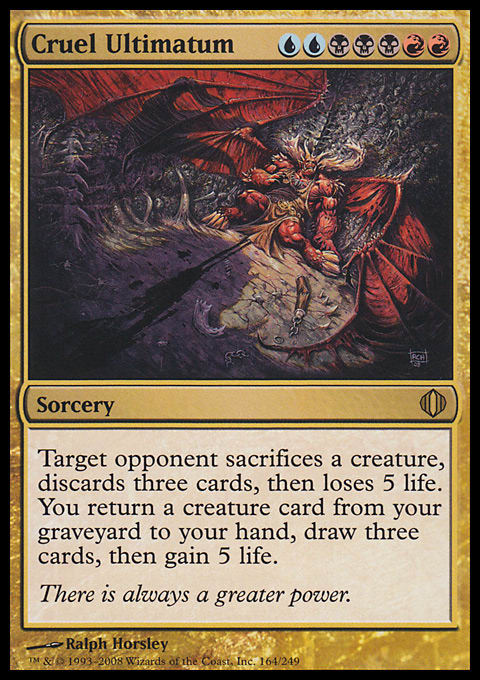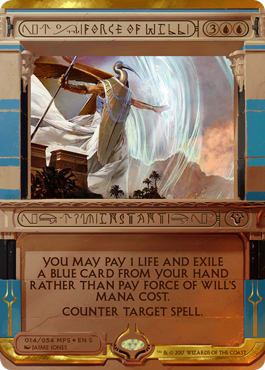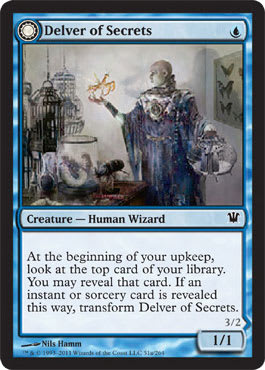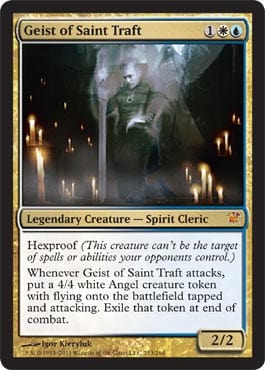But the community doesn’t always know best. There is a large outcry against counter magic, and a lot of the arguments have salient points. However, there are lessons to be learned from past mistakes and relevant things to be taken from the other side of the argument as well. Today, what I will be doing is taking a detailed look at counter magic, both its history and the modern implementation, and discussing what I believe to be the proper role of counter magic within the game.
The Problem of Counter Magic
I will not deny that counter magic has been a problem in Magic’s past. In the early portion of the game, the counters WotC printed were far more efficient than the threats, thus creating the unfun problem of everything being countered. Even so, that is not the only reason counter magic can be powerful. Let’s take a look at two modern-era decks:
"W/U Delver by I don’t remember"
- Creatures (14)
- 3 Invisible Stalker
- 4 Delver of Secrets
- 4 Snapcaster Mage
- 3 Geist of Saint Traft
- Spells (26)
- 2 Gut Shot
- 3 Thought Scour
- 4 Mana Leak
- 4 Vapor Snag
- 1 Timely Reinforcements
- 4 Gitaxian Probe
- 4 Ponder
- 2 Runechanter's Pike
- 2 Sword of War and Peace
- Lands (20)
- 9 Island
- 3 Moorland Haunt
- 4 Glacial Fortress
- 4 Seachrome Coast
- Sideboard (15)
- 2 Ratchet Bomb
- 2 Phantasmal Image
- 2 Oblivion Ring
- 3 Celestial Purge
- 2 Mental Misstep
- 2 Negate
- 1 Corrosive Gale
- 1 Timely Reinforcements
"Faeries by Alex Bertoncini"
- Creatures (17)
- 2 Pestermite
- 3 Sower of Temptation
- 4 Mistbind Clique
- 4 Scion of Oona
- 4 Spellstutter Sprite
- Spells (18)
- 3 Cryptic Command
- 3 Terror
- 4 Rune Snag
- 4 Ancestral Vision
- 4 Bitterblossom
- Lands (25)
- 4 Island
- 4 Faerie Conclave
- 4 Mutavault
- 4 River of Tears
- 4 Secluded Glen
- 4 Underground River
- 1 Pendelhaven
- Sideboard (15)
- 4 Bottle Gnomes
- 3 Damnation
- 2 Peppersmoke
- 2 Slaughter Pact
- 4 Thoughtseize
There are a number of players who believe that Delver and Faeries are problem children—that they represent issues for their respective formats. What made these decks so powerful was their disruptive potential. Both of these decks use counter magic to its full strength, although Delver relies on it less than Faeries.
So, how are these decks taking advantage of counter magic? What is the role the counterspells (Mana Leak, Rune Snag, Spellstutter Sprite, and Cryptic Command) serve?
The key thing to remember about counter magic is that the value of a counterspell is proportional to the value of the spell it is countering. This is why you very rarely see spells such as Avacyn's Pilgrim countered, whereas spells such as Primeval Titan, Cruel Ultimatum, and Tooth and Nail often have counterspells directed at them. In general, a counterspell’s impact on the game is the impact of the spell it is stopping. There are situations in which cards such as Avacyn's Pilgrim are high-impact, but in general, spells that are fairly low-impact by themselves tend not to be countered.
But why is this fact important?
Because counterspells, as with many different types of Magic cards, can be used offensively as well as defensively. One of the times counterspells become oppressive is when decks are able to take full advantage of both the offensive and defensive uses of counter magic. Faeries and Delver are great examples of this in action.
In Delver, Mana Leak is a great tempo control card. It counters threats ranging from Huntmaster of the Fells, Hellrider, Strangleroot Geist, and Gideon Jura all the way up to and including defensive spells such as Day of Judgment, Oblivion Ring, and Terminus. The dual functionality of Mana Leak as both an offensive and defensive measure ensures that the card is always able to stop a high-impact spell, and it thus ensures Mana Leak is always high impact.
Faeries was a slower, more defensive deck, and thus relied more heavily on the defensive functionality of counter magic. However, make no mistake that Faeries could take full advantage of the tempo functionality of its counter magic, especially in the form of Spellstutter Sprite. This was especially true when the deck was protecting an early Bitterblossom, as the advantage generated by that card snowballed out of control very quickly. Volcanic Fallout was necessary for a reason.
The power of this dual functionality stems from the offensive capabilities of counter magic. Consider the dichotomy:
- If counter magic is used defensively, all that is accomplished is that both players have tapped some mana and discarded a card. While you can gain advantage by trading a small amount of your mana for a larger amount of the opponent’s, the disparity between threats and answers is becoming smaller, and thus, the advantage gained this way is minimal per interaction. In essence, sure, you can counter a Primeval Titan, but all you’ve accomplished is stopping the Primeval Titan from killing you. The main purpose of this is to allow you to make land drops and buy time to advance your game plan in other ways.
- If counter magic is used offensively, it is used to protect an advantageous board state. Thus, the player playing the counter magic is allowed to increase his advantage in the following turn. What the counterspell buys is the opportunity to put the opponent in a deeper hole. In many situations, if used offensively, counter magic can simply kill the opponent, especially when combined with strong threats such as Geist of Saint Traft or strong threat enhancers such as Mirrodin-block Swords.
What’s important to note is that counter magic can’t directly help you recover from a disadvantaged position. The functionality of counter magic is twofold:
- Stop you from falling further behind
- Allow you to pull further ahead
One of these two functionalities has a much higher chance of being problematic than the other. If the primary purpose of counter magic is to keep you from falling further behind so you can attempt to use other defensive spells to catch up, counter magic tends to be fine. However, in situations where it is also allowed to cement advantages, it feels oppressive. Frequently, when you play against Delver, what is killing you is Mana Leak or the threat of Mana Leak. The ability of Delver to take advantage of that spell to protect its onboard advantage is at the heart of the deck’s power.
But what about Draw-Go-style decks? Can’t they be oppressive? Well, of course. I mean, this deck existed after all:
"Forbidian by Jon Finkel"
- Creatures (12)
- 1 Silver Wyvern
- 3 Tradewind Rider
- 4 Man-o'-War
- 4 Ophidian
- Spells (27)
- 2 Capsize
- 2 Mana Leak
- 3 Forbid
- 4 Counterspell
- 4 Impulse
- 4 Whispers of the Muse
- 4 Legacy's Allure
- 4 Sapphire Medallion
- Sideboard (15)
- 1 Disrupt
- 4 Hydroblast
- 2 Meekstone
- 2 Null Rod
- 3 Phyrexian Furnace
- 3 Suq'Ata Firewalker
The real oppressive card in this deck was Forbid, which has buyback, and it thus turned every two otherwise useless cards into an additional counterspell. The deck might not look like it has a ton of counter magic, but the presence of Forbid means that it does actually plan to counter many, many spells over the course of the game.
This is, perhaps, a Draw-Go deck that looks more like what you would expect:
"Draw-Go by Randy Buehler"
- Creatures (1)
- 1 Rainbow Efreet
- Spells (33)
- 1 Memory Lapse
- 2 Dissipate
- 3 Forbid
- 3 Mana Leak
- 4 Counterspell
- 4 Dismiss
- 4 Force Spike
- 4 Impulse
- 4 Whispers of the Muse
- 4 Nevinyrral's Disk
- Lands (26)
- 18 Island
- 4 Quicksand
- 4 Stalking Stones
- Sideboard (15)
- 2 Capsize
- 1 Grindstone
- 4 Hydroblast
- 4 Sea Sprite
- 4 Wasteland
Decks of this style can be oppressive, but there is one thing about them that is relatively easy to control from a design standpoint: counterspell density.
Take a look at the Draw-Go list again. Draw-Go runs twenty-one counterspells spread across six unique cards, all at 1 to 3 mana. This is not atypical for this particular type of deck. Thus, in order for Draw-Go to be an option, a wide variety of powerful, cheap counter magic needs to exist. There is, of course, no reason that a wide variety of powerful, cheap counter magic should exist, so Draw-Go as an archetype can be controlled simply by controlling the density of counter magic.
But what about Forbidian? Well, Forbidian was the result of Forbid, which provides a high counter density all by itself. Buyback on a counterspell equals bad idea. Who woulda thunk that repeatable counter magic could be a problem? I know—shocking (but also easily avoidable).
The key here is to think about the efficiency of the counter magic from three perspectives: time, cards, and mana.
- Time efficiency is concerned with when the counter happens on the curve. This dictates what threats the counter is effective against. The later the counter happens, the more it has to do beyond just countering the spell.
- Mana efficiency dictates what you get when you spend the counter. Countering a spell is worth about 2.5 mana, and anything over that, you need to get added value for. The question is: Is the added value worth it?
- Card efficiency is whether the counter allows you to gain a benefit that is worth a card in and of itself. Examples include Dismiss and Rewind. This is also important when evaluating the overall efficiency of a counter.
If counterspells are too cheap and efficient, they become a problem. However, counterspells are also among the easiest card types to evaluate in a vacuum because none of the criteria I listed above are very format-dependent. Thus, any reasonable look at counter magic should be able to discern the efficiency of a designed counter the vast majority of the time.
Thus, the counter-everything-you-play angle of oppression is easy to control with the density of relevant counter magic printed for a format, making this sort of problem one that is handled well already.
The real problem is the offensive functionality of counter magic. This is much harder to deal with because all it requires is counter magic that can be cast next to cheap, effective threats. Cheap, effective threats not only come with much greater frequency, but they are also the sort of cards that a lot of players find fun. Thus, the only real viable solution here is to limit the ability of the counter magic to be cast next to them. We’ll look at this later.
The Benefits of Counter Magic
I’ve talked a little about the pitfalls and perils associated with counter magic; now, I want to talk about the benefits.
So, you don’t like having your spells countered huh? That sinking feeling when your opponent taps 2 to 4 mana and simply says “no” isn’t something you like, right? Well, I’m sorry to tell you that it’s sort of a necessary evil at this point—especially if you play Standard. Why? Well, let me ask you some questions.
Do you like Cruel Ultimatum? How about Primeval Titan? What about Eternal Witness? Are you a fan of Profane Command or Primal Command? Do you get warm, fuzzy feelings inside when you cast Recurring Nightmare? Is Tooth and Nail your cup of tea? Do you find cards like Wild Pair exciting? What about Elspeth, Knight-Errant or Garruk Wildspeaker? Are you good friends with Regal Force or Woodfall Primus? If not, do you have fun when your opponents undergo a Rude Awakening?
I’ve spoken before about the need for a system of checks and balances in Standard. The Standard format has long been full of powerful noncreature cards that are capable of taking over a game in addition to creatures the primary impacts of which are comes-into-play triggers. These types of cards are not going away, but what does that have to do with counter magic?
Counter magic is a method of keeping these spells in check. It’s a bad thing for formats to be dominated by any individual card or archetype, and the best method for preventing this is to enable counter-strategies. Counter magic serves as a balancing influence to these types of spells. In particular, counter magic serves to balance out powerful instants, sorceries, and creatures that influence the game primarily through their comes-into-play abilities. These types of spells often need to be stopped before they hit the table, and thus, the format turns to counter magic to accomplish that. This is the role of counter magic in achieving format balance.
Cheap, efficient counter magic also serves to check the speed of a format. Because they are such a powerful defensive measure, counterspells slow the format down by preventing all-in combo wins. This is exactly why Legacy and Vintage can exist without being completely degenerate. The presence of Force of Will in both of these formats prevents them from degenerating into goldfish matches.
As far as Force is concerned, I am interested to see where Modern goes. I believe that in the future, Modern will need a good pitch counter. It may be Force of Will or it may be some other variant printed, but the format is powerful enough and fast enough that I believe the counter-influence of a 0- or 1-mana hard counter will be necessary. Still, nothing is written in stone, and I don’t have a crystal ball.
The Delicate Balancing Act
Counter magic is among the most powerful effects WotC has at its disposal. It is simultaneously one of the hallmarks and one of the problems Magic has. It is both highly integral to the way the game operates and powerful enough to dominate formats consistently. Thus, designing counter magic is a delicate balance between making it effective and making it overpowered.
There are three angles from which to deal with counter magic:
Angle 1 – Threat Control
The castability of counters in their offensive function is a major concern. In order for counters to function at their offensive peak, they need to be easily castable alongside the threats they are protecting. This occurs in one of two conditions:
- The threats are blue.
- The mana fixing is sufficiently good enough to cast counters next to nonblue threats.
Both of these things are controllable. Cards such as Delver of Secrets can be designed in such a way as to limit the threat density blue has at 1 to 3 mana. This will weaken the offensive potential of counter magic and help to check the power of cards like Mana Leak in Standard. The mana fixing is also something that can be controlled. The better the mana fixing, the more likely a spell such as Cryptic Command or Counterspell (both costed to prevent splashing) is going to be splashed. The ability to splash counter magic can also contribute to it dominating a format.
This is why, in some ways, Counterspell might actually be healthier for Standard than Mana Leak. Mana Leak is splashable with far worse mana fixing than Counterspell, and in its offensive functionality, Mana Leak is basically a hard counter. Thus, the change from Mana Leak back to Counterspell may actually help the problem. I don’t know for sure, but I think it is worth trying.
Angle 2 – Quantity Control
Controlling the quantity of counter magic printed in any given format and at any given mana cost is also a way of controlling the card type. For example, if only three counterspells are legal, you can only run twelve counters in your deck, severely limiting the potential of Draw-Go-style decks, especially if one of these counters is sufficiently inefficient to make that option unattractive. Thus, controlling the frequency of occurrence of counterspells is a way of allowing them to serve their function while preventing them from being oppressive.
Angle 3 – Efficiency Control
Like all Magic cards, controlling the efficiency of any given counter is also a way of controlling its playability and thus its frequency of occurrence. The less efficient your counter, the less likely it is to see play. Considering that counter magic has relatively few standards for efficiency, this is a great way of controlling the effectiveness of counter magic.
Conclusion
I believe that counter magic serves a necessary place in Magic, and understanding that place is the first step toward understanding the functionality and design of the card type. I believe that a happy medium can be achieved where counter magic can become a fun, interactive part of the game. I believe that it is possible to reform counter magic and change its reputation to make it no more than just another way of dealing with a threat—no more and no less than the Doom Blades you see flying around all over the place.
Understanding is the first step toward a solution, and I believe that the problem presented by counter magic can be solved. WotC is moving in the right direction, and I hope that in the next few years, they will find the appropriate balance.
Until next time, may you see the problem for what it truly is. It’s not Mana Leak, it’s Mana Leak protecting Delver of Secrets and Geist of Saint Traft.
Chingsung Chang
Conelead most everywhere and on MTGO
Khan32k5 at gmail dot com













